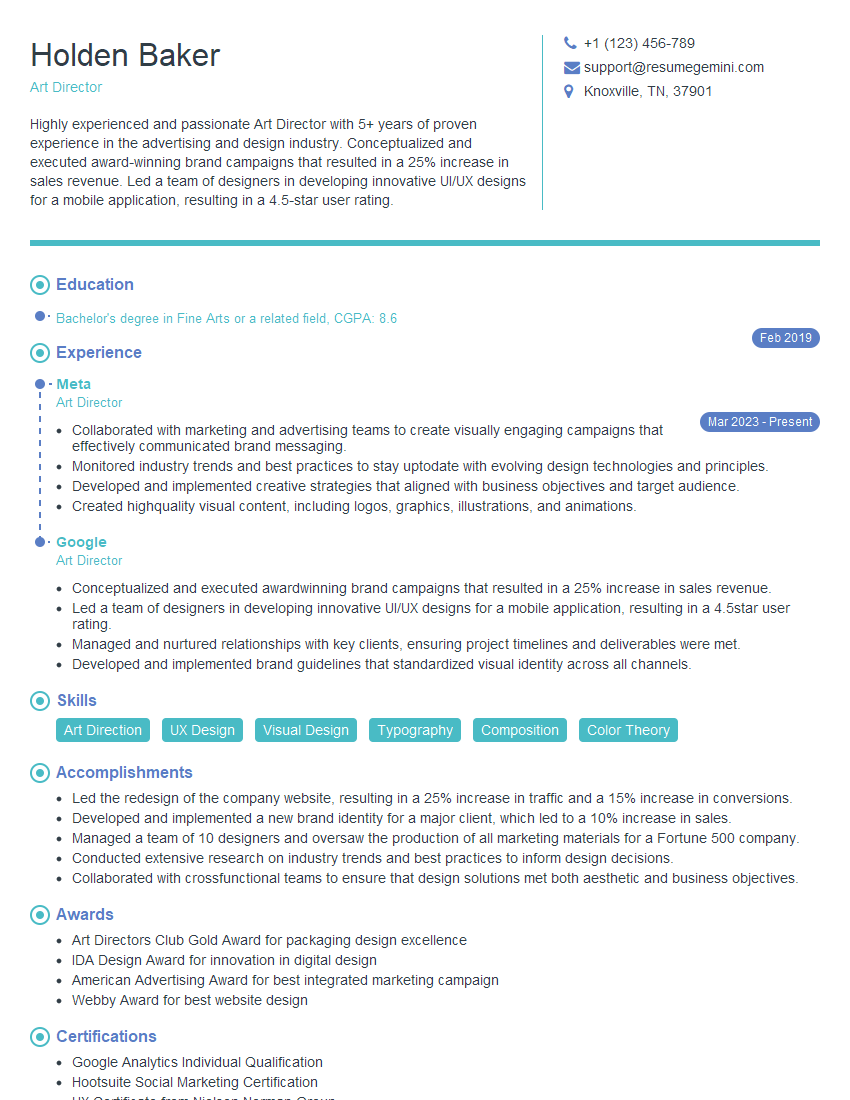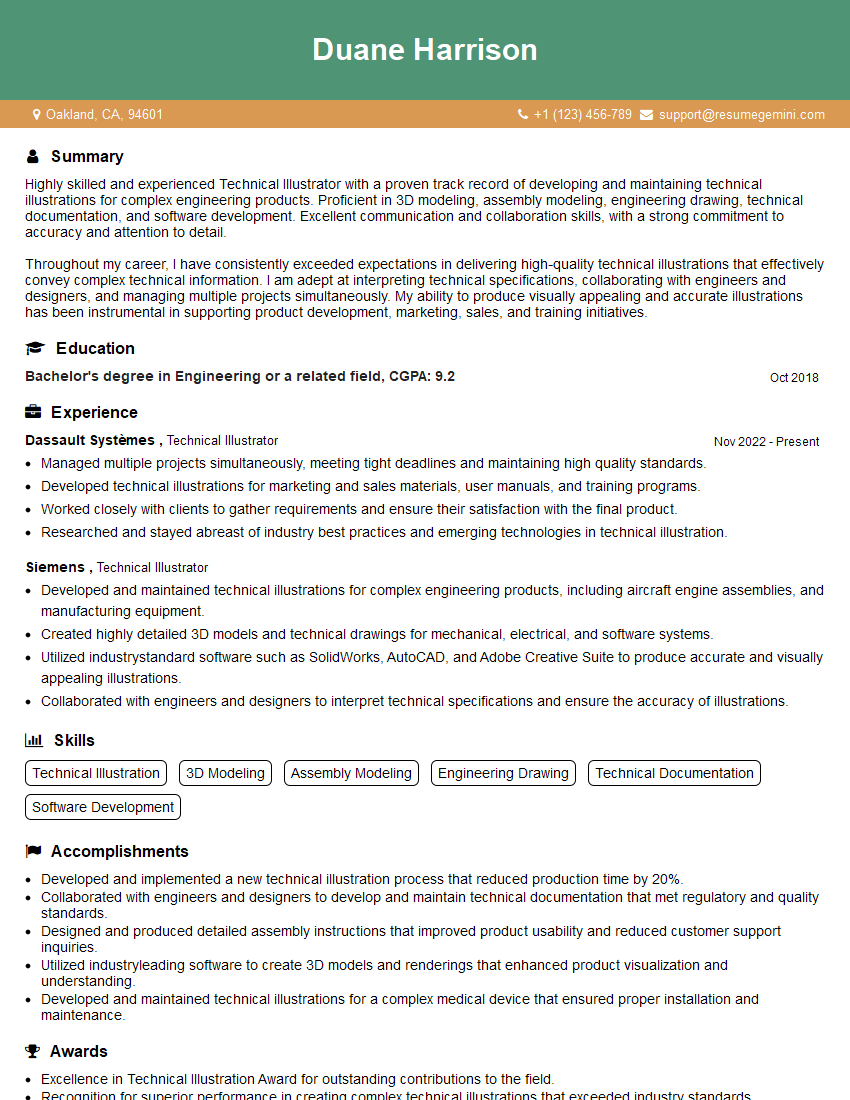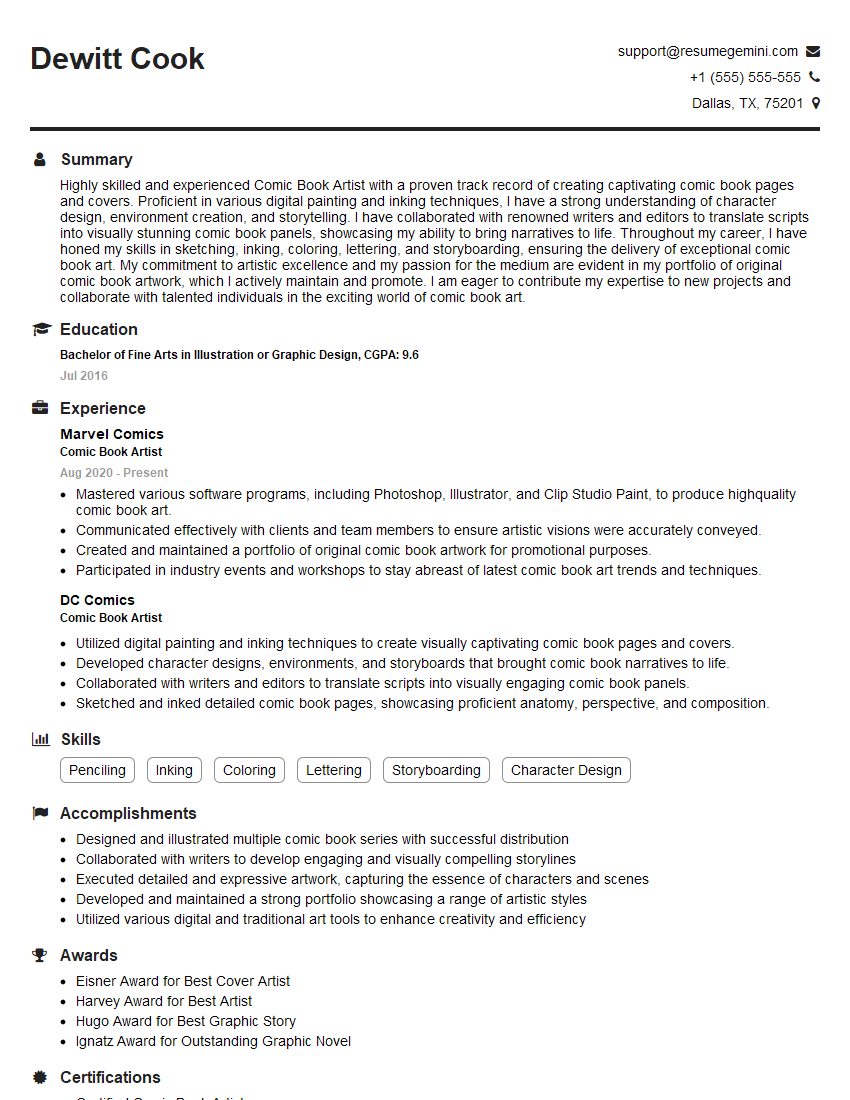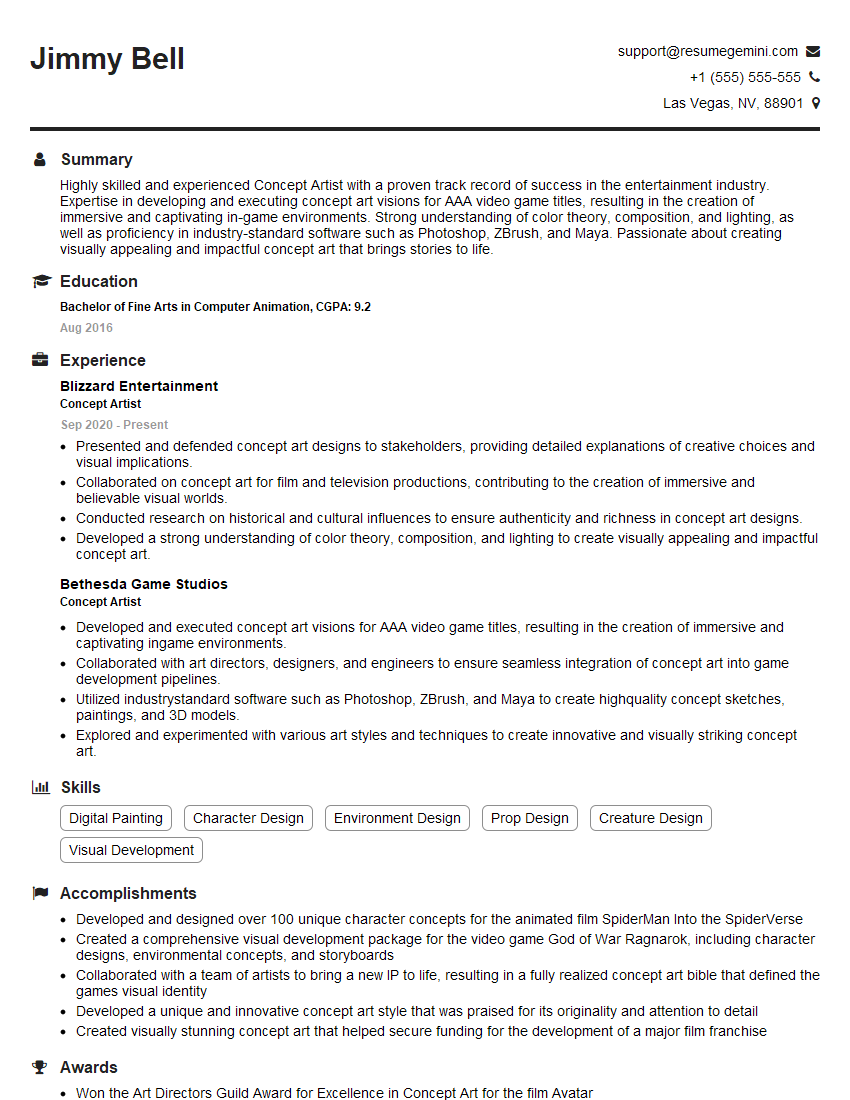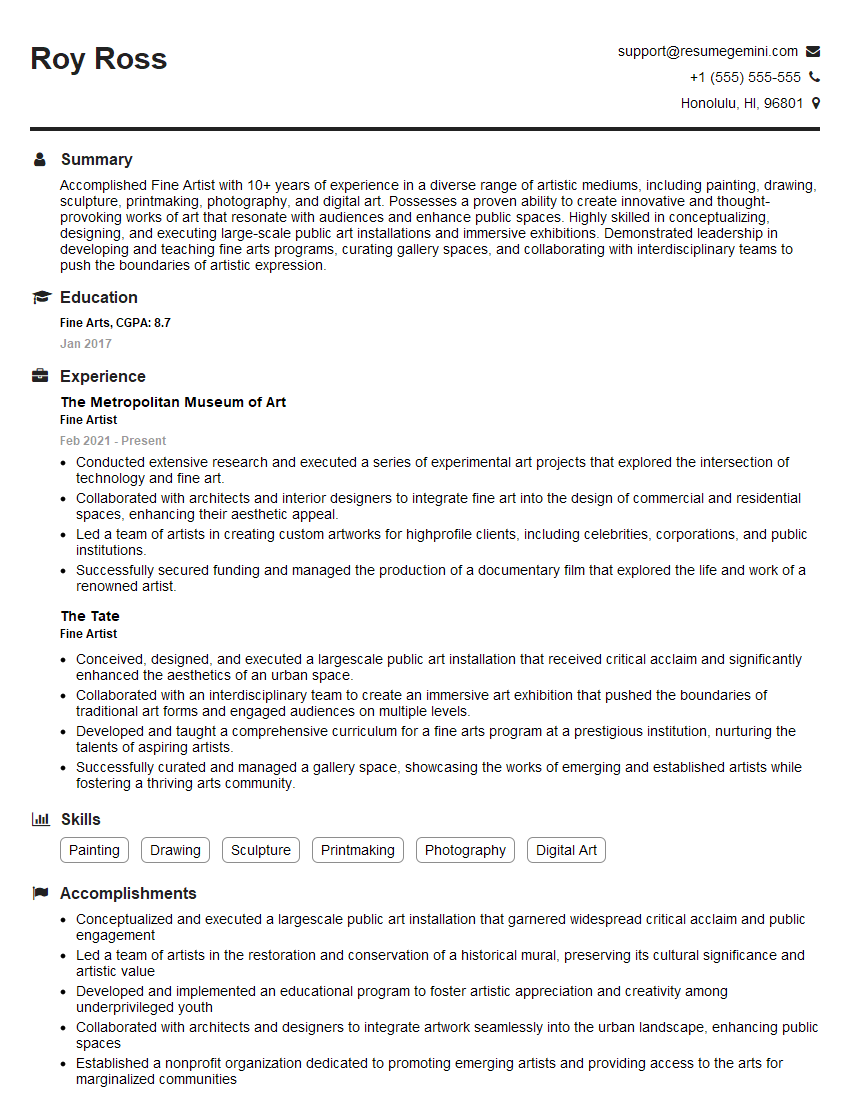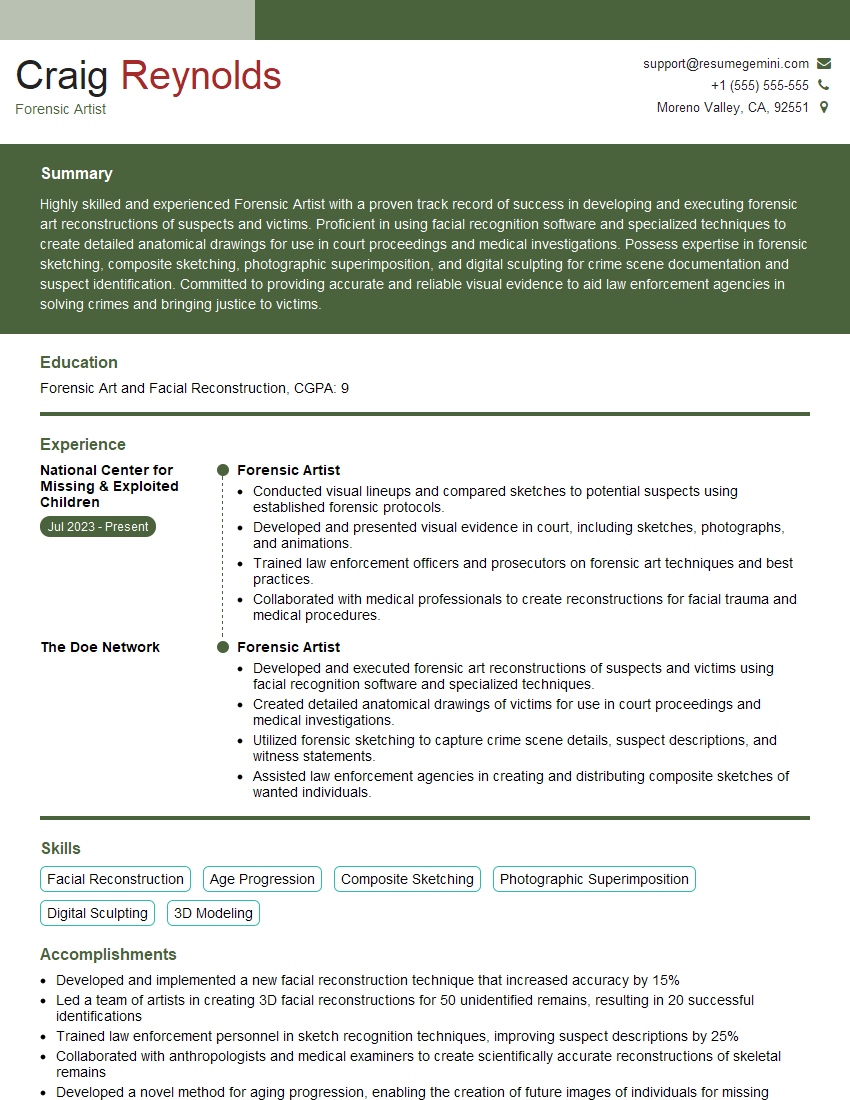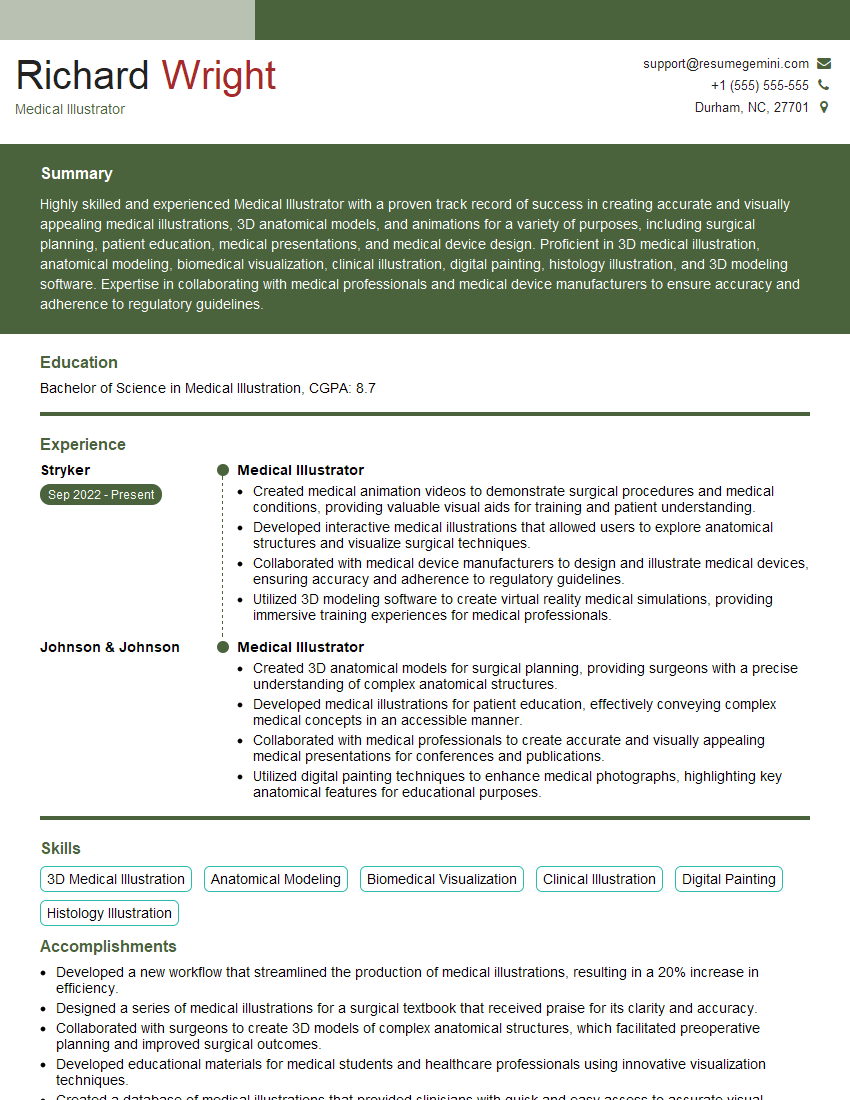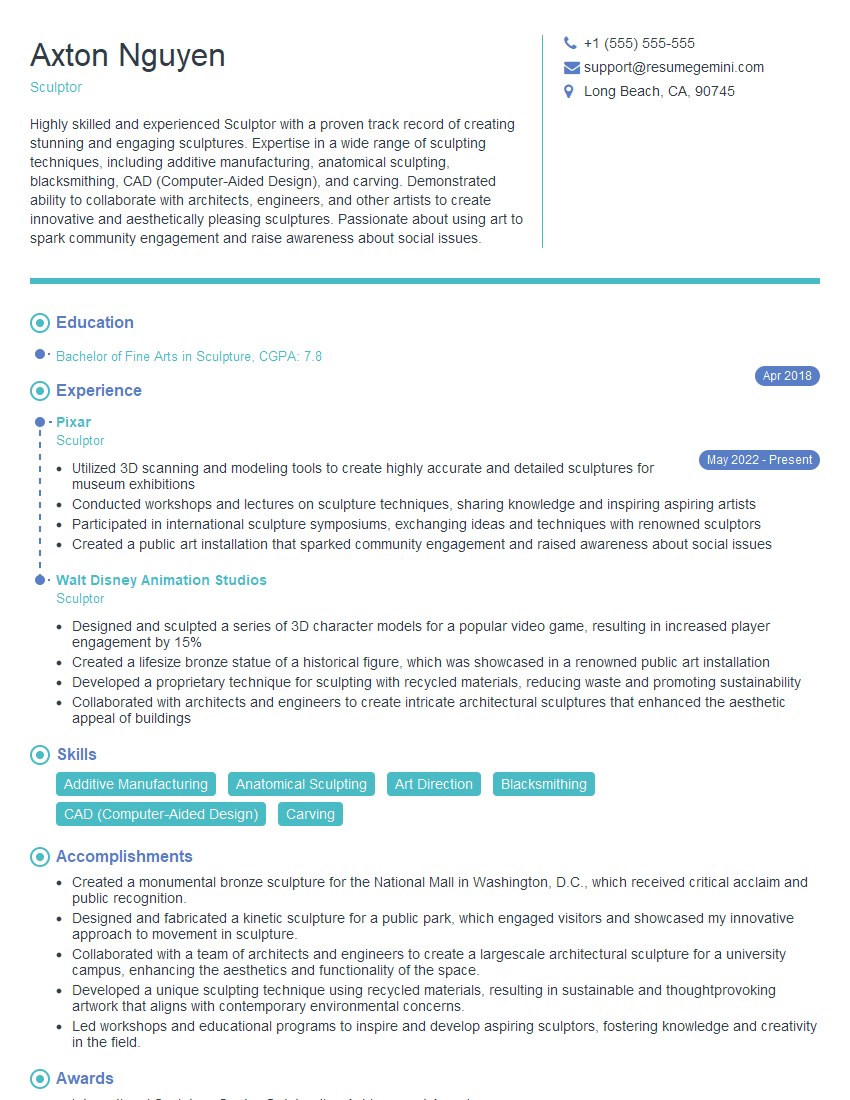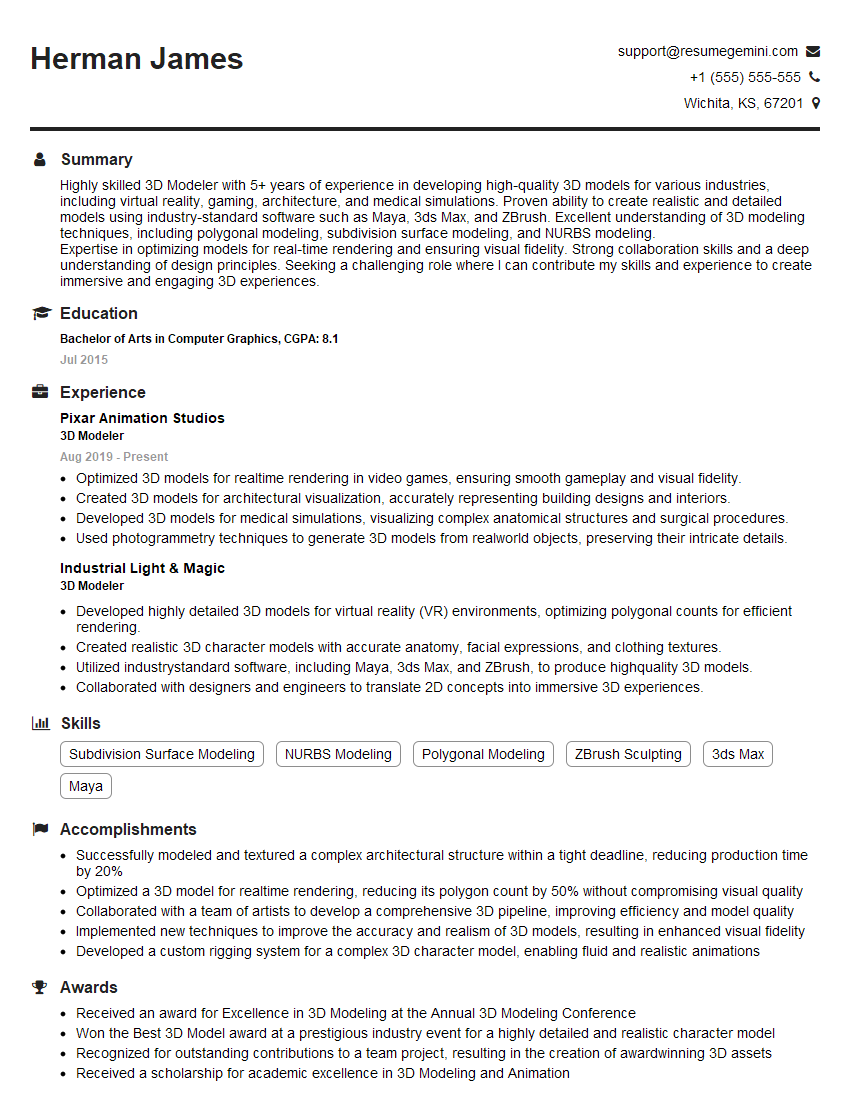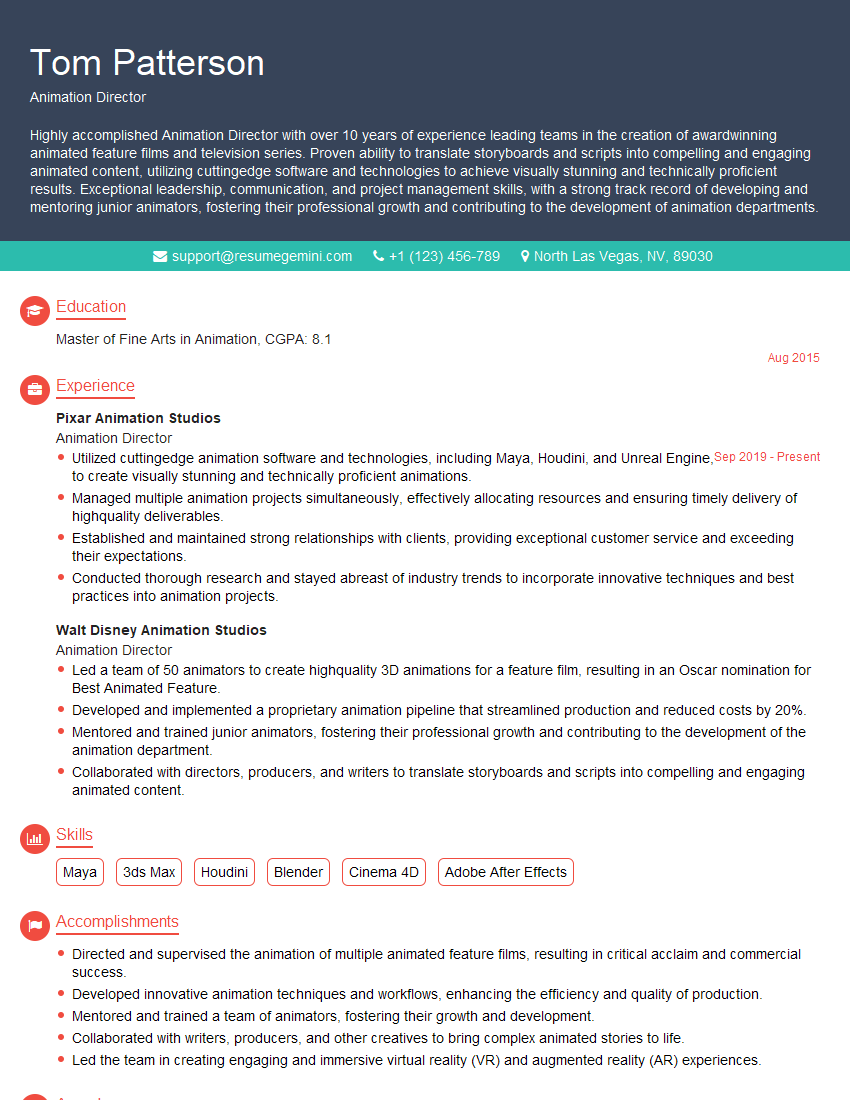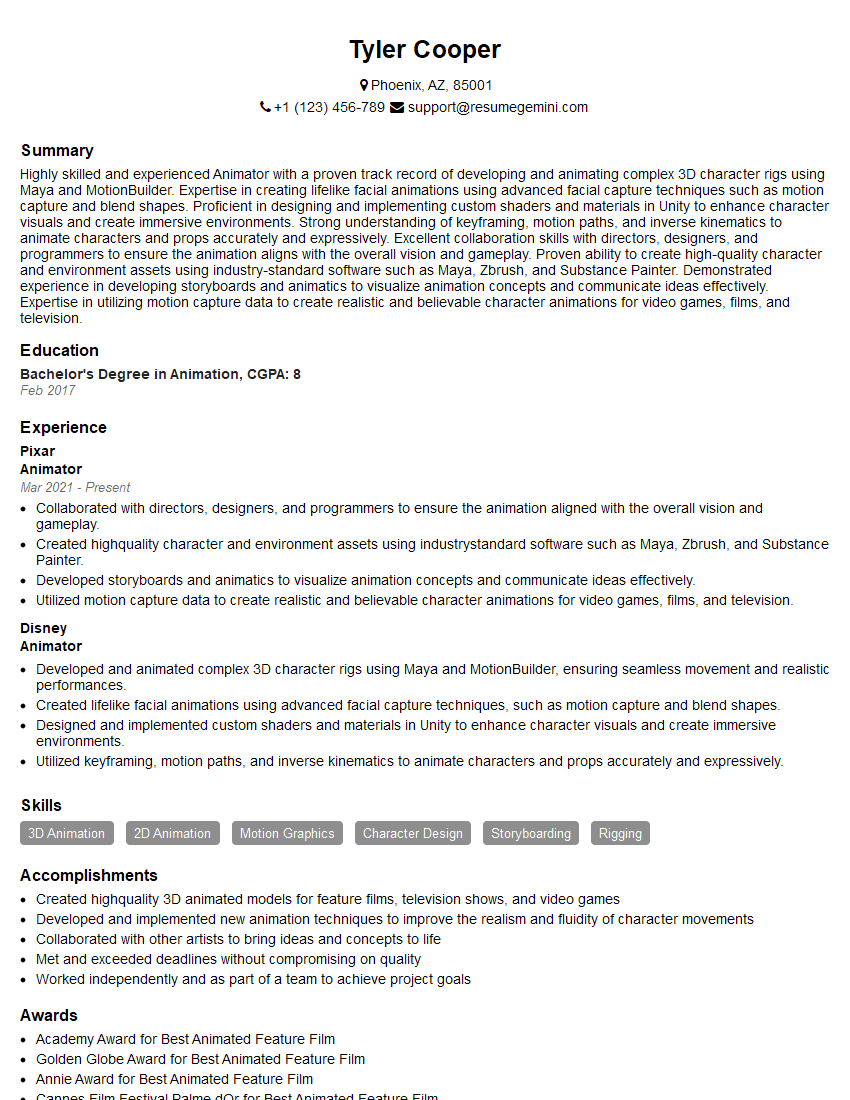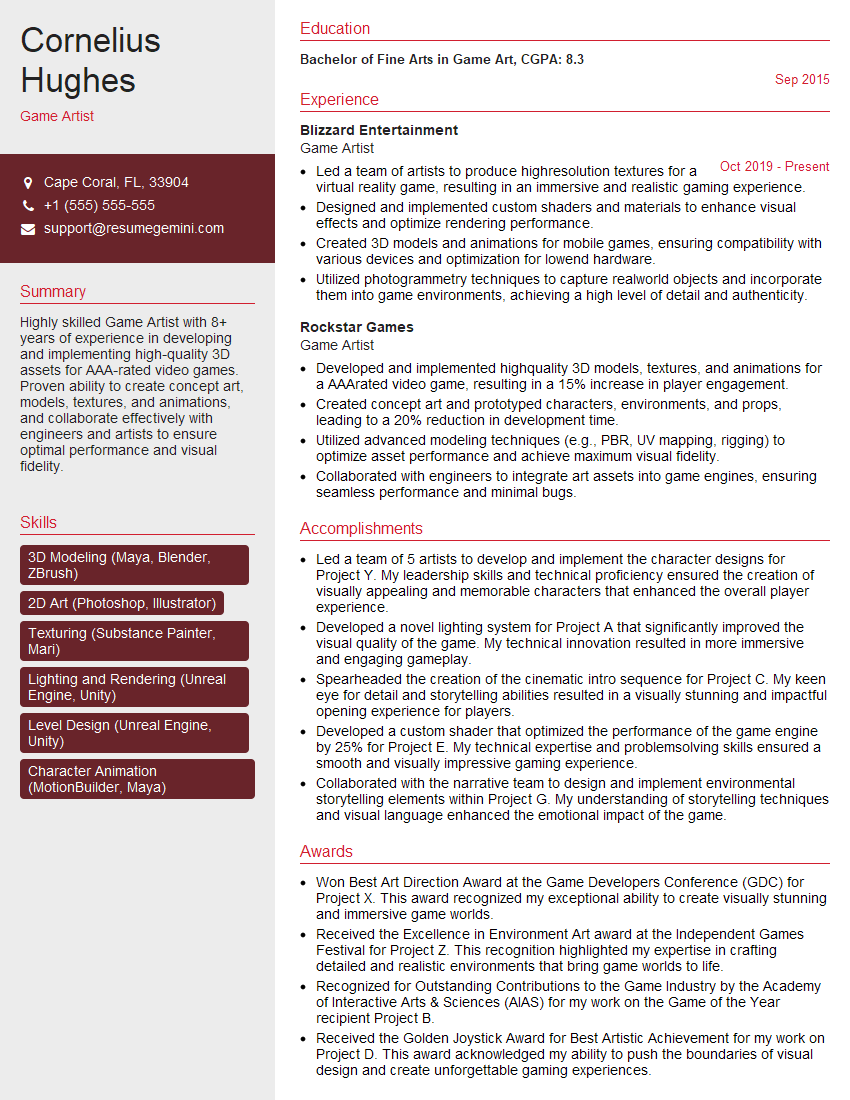The right preparation can turn an interview into an opportunity to showcase your expertise. This guide to Anatomy for Artists interview questions is your ultimate resource, providing key insights and tips to help you ace your responses and stand out as a top candidate.
Questions Asked in Anatomy for Artists Interview
Q 1. Describe the difference between the male and female skeletal structure.
While the overall skeletal structure is similar between males and females, several key differences exist. These differences are often subtle but crucial for accurate figure drawing. Generally, the male skeleton tends to be larger and more robust, exhibiting more pronounced muscle attachments and bone markings. The female skeleton is typically more gracile, with smoother bone surfaces and wider pelvic structures.
- Pelvis: The female pelvis is wider and shallower than the male pelvis, adapted for childbirth. This difference is readily apparent in the hip bones’ shape and the wider pubic arch.
- Skull: Male skulls generally have more pronounced brow ridges, heavier jawlines, and a more prominent occipital bone (at the back of the skull). Female skulls tend to be smoother and more delicate.
- Rib Cage: The male rib cage is usually longer and narrower than the female rib cage, which is often broader and shorter.
- Long Bones: While the proportions differ, the long bones (like the femur and humerus) in males are generally longer and thicker than in females.
Understanding these subtle differences is crucial for creating believable and accurate depictions of both male and female figures. Artists must be attentive to the proportions and overall shape of the pelvis and rib cage to correctly represent the unique features of each sex.
Q 2. Explain the function of the major muscle groups in the human body.
Major muscle groups work in coordinated systems, and their functions can be grouped into categories: movement, posture, and respiration. Here are some prominent examples:
- Legs: The quadriceps (front of thigh) extend the knee; the hamstrings (back of thigh) flex the knee; the gluteus maximus (buttocks) extends the hip and helps with external rotation. These all contribute to locomotion.
- Arms: The biceps brachii (front of upper arm) flexes the elbow, and the triceps brachii (back of upper arm) extends the elbow. The deltoids (shoulders) abduct, flex, and extend the arm at the shoulder.
- Torso: The abdominal muscles (rectus abdominis, obliques) flex the trunk and rotate the torso, playing crucial roles in posture and balance. The latissimus dorsi (back) extends, adducts, and internally rotates the arm. The erector spinae muscles along the spine support posture and allow for trunk extension.
- Neck and Head: The sternocleidomastoid muscles (neck) flex the head and rotate it. Several smaller muscles control intricate facial expressions.
Remember, muscles rarely act alone. They work synergistically, with some contracting (shortening) while others relax (lengthen) to produce smooth, controlled movement. Understanding these groups and their interactions is key to accurately representing human form and movement.
Q 3. Illustrate the relationship between muscle and bone structure in the human arm.
The relationship between muscle and bone in the arm is a beautiful example of a lever system. Bones provide the rigid framework, while muscles provide the motive force. Consider the upper arm:
- Humerus: The long bone of the upper arm serves as the lever arm.
- Biceps Brachii and Brachialis: These muscles are the primary flexors (benders) of the elbow joint. They attach to the humerus and radius, pulling on the radius to bend the elbow.
- Triceps Brachii: This muscle is the primary extensor (straightener) of the elbow joint. It attaches to the humerus and ulna, pulling on the ulna to straighten the elbow.
The forearm’s bones (radius and ulna) are involved in pronation (palm down) and supination (palm up) movements, driven by muscles like the pronator teres and supinator. Understanding these muscle origins, insertions, and actions allows artists to depict realistic arm poses and the subtle changes in muscle shape during different actions.
Q 4. How does understanding anatomy improve the accuracy of figure drawing?
Understanding anatomy significantly elevates the accuracy of figure drawing. It moves the process from simply copying shapes to understanding the underlying structure. Instead of just drawing a ‘limb’, an artist who understands anatomy can draw a limb accurately reflecting the underlying bone structure, muscle mass, and tendon connections.
- Accurate Proportions: Knowledge of bone structure allows for precise proportions and avoids common errors in figure drawing.
- Realistic Forms: Understanding the underlying musculature allows for realistic rendering of muscle shapes, their changes under different poses and movements.
- Plausible Movement: The artist can depict believable movement by understanding how muscles and bones interact to produce specific actions.
- Correct Weight and Balance: Understanding anatomy informs an artist’s understanding of weight distribution and balance in a figure. It allows them to create a more dynamic and stable pose.
Essentially, an anatomical foundation allows the artist to depict the human form not just as a surface, but as a three-dimensional structure with weight, movement, and character.
Q 5. What are the key anatomical features to consider when depicting movement?
When depicting movement, key anatomical features to consider include:
- Joint Action: Understanding the range of motion for each joint (e.g., flexion, extension, abduction, adduction, rotation) is crucial. This determines the limits of plausible poses.
- Muscle Contraction and Relaxation: Observe how muscles bulge and shorten during contraction and lengthen and relax during extension. This significantly impacts the form and contour of the body.
- Dynamic Equilibrium: The artist needs to showcase a sense of balance and weight distribution, understanding the interplay of gravity and muscle engagement to maintain pose stability.
- Skeletal Structure: Bones serve as the foundation of movement. Their structure and articulation (joints) influence the overall pose and fluidity of movement.
- Momentum and Inertia: In action poses, suggest the sense of movement by subtly indicating the momentum and inertia of the figure.
A thorough understanding of these elements is essential for creating dynamic and convincing depictions of human movement.
Q 6. Explain the importance of foreshortening in depicting anatomical forms.
Foreshortening is the technique of depicting an object or figure in perspective so that it appears shorter than it actually is because it is angled toward the viewer. In anatomical drawing, it’s crucial for creating a sense of depth and realism, particularly in dynamic poses. Consider these points:
- Limb Positioning: When limbs are angled towards the viewer, they appear shorter than limbs viewed from the side. Foreshortening accurately represents this distortion.
- Muscle Distortion: Foreshortening affects the appearance of muscles. Muscles that are foreshortened might appear compressed or flattened.
- Perspective and Depth: Foreshortening creates the illusion of depth on a two-dimensional surface, adding realism to the figure.
- Realistic Proportions: Incorrect foreshortening can easily lead to anatomical inaccuracies and distorted proportions. Mastering it is key to accurate anatomical representation.
Failing to accurately apply foreshortening can result in flat, unrealistic depictions. It is essential for creating believable and dynamic compositions. Practice with simple shapes first, then gradually progress to more complex forms.
Q 7. Describe the different types of joints and their range of motion.
Joints are classified by their structure and function. The range of motion varies widely depending on the type:
- Fibrous Joints: These joints have no joint cavity and are connected by fibrous connective tissue. They are generally immovable or only slightly movable. Examples include sutures in the skull.
- Cartilaginous Joints: These joints are connected by cartilage, allowing for limited movement. Examples include the intervertebral discs in the spine.
- Synovial Joints: These joints have a joint cavity filled with synovial fluid, allowing for a wide range of motion. This is the most common type of joint in the body. They can be further categorized based on their shape and movement:
- Ball-and-socket (e.g., shoulder, hip): Allow movement in multiple planes, including flexion/extension, abduction/adduction, and rotation.
- Hinge (e.g., elbow, knee): Allow movement primarily in one plane, flexion and extension.
- Pivot (e.g., between the atlas and axis vertebrae): Allow rotation.
- Saddle (e.g., thumb): Allow movement in two planes, flexion/extension and abduction/adduction.
- Gliding (e.g., carpals in the wrist): Allow for sliding movements.
- Condyloid (e.g., wrist): Allow movement in two planes, flexion/extension and abduction/adduction.
Understanding the structure and function of joints is critical for artists because it determines the range of motion possible and significantly influences the overall appearance of the body and how it can move.
Q 8. How does understanding the skeletal system inform your approach to drawing drapery?
Understanding the skeletal system is foundational to drawing believable drapery. Drapery doesn’t just drape; it responds to the underlying form. Think of the skeleton as a landscape upon which the fabric is laid. The ribcage creates a broad curve under a shirt, the shoulder blades influence how fabric falls over the back, and the pelvis dictates the drape of clothing around the hips. Ignoring the underlying bone structure results in lifeless, unrealistic folds.
For example, when drawing a figure wearing a robe, I visualize the rib cage’s rounded form pushing outwards against the fabric, creating gentle bulges. The spine’s gentle curves create subtle shifts in the fabric’s direction. The sharp angles of the hip bones will cause the fabric to cling tightly in some areas and fall away in others. This understanding allows me to create natural-looking folds and creases instead of just generic folds.
Essentially, I use the skeleton as a three-dimensional armature, influencing the way the fabric hangs and folds. This gives the figure a sense of weight, movement, and volume.
Q 9. Discuss the impact of light and shadow on revealing anatomical structure.
Light and shadow are crucial for revealing anatomical structure because they define form. Think of how a sphere illuminated from above casts a shadow on its bottom half. This same principle applies to the human body. Where light hits directly, the surface appears bright and highlights muscle bulges, bone protrusions, or folds in the skin. Areas in shadow reveal the recesses and valleys of the form.
For instance, when drawing a bicep, the light would highlight the peak of the muscle, creating a brighter area. The shadow along the inner portion of the arm would define the depth and shape of the muscle, and the transition between light and shadow (the halftone) further refines the form. The interplay of light and shadow allows the viewer to understand the three-dimensionality of the body. Mastering light and shadow is mastering the rendering of form, making anatomy visually accessible.
By carefully observing and replicating how light falls on the human form, we can create a sense of volume and depth, making the anatomy believable and visually engaging.
Q 10. How do you use anatomical knowledge to create believable expressions?
Creating believable expressions relies heavily on understanding the underlying musculature of the face. Different muscles are responsible for specific expressions—the orbicularis oculi for squinting, the zygomaticus major for smiling, etc. Knowledge of these muscles allows me to subtly adjust the forms to convey specific emotions.
For example, to depict sadness, I might slightly lower the corners of the mouth, using the depressor anguli oris muscle, and possibly furrow the brow, activating the corrugator supercilii muscles. The subtle interplay between these muscles creates a convincing display of sadness. Knowing which muscle groups are involved prevents creating exaggerated or unrealistic expressions.
In essence, I use anatomical knowledge to precisely control the subtle shifts in the facial features, creating a nuanced and believable emotional response.
Q 11. Explain how muscle attachments affect the surface form of the body.
Muscle attachments significantly influence the body’s surface form. Muscles originate from one point (origin) and insert into another (insertion). The way they attach and their shape when contracted or relaxed directly affects the surface contours.
Take the trapezius muscle, for example. It originates from the skull and spine and inserts into the scapula and clavicle. Its shape and tension drastically alter the appearance of the neck and shoulders. When the trapezius contracts (e.g., shrugging), it creates a noticeable bulge at the upper back and neck. Conversely, when relaxed, it presents a smoother form.
Understanding muscle attachments allows me to accurately depict the subtle changes in form that happen during movement or under different states of tension. This transforms a static figure into a dynamic and believable representation of the human body. It’s not enough to just know the names of muscles; one must also understand their three-dimensional position and their influence on the body’s surface.
Q 12. Describe the anatomical differences between the hands and feet.
The hands and feet, while both possessing a similar skeletal structure based on multiple bones connected by joints, exhibit significant anatomical differences that impact their function and appearance. Hands are designed for grasping and manipulation, while feet are specialized for support and locomotion.
Hands are more dexterous, with longer, more mobile fingers and a relatively larger, more complex arrangement of intrinsic muscles enabling fine motor skills. The thumb’s opposability is a key feature absent in the foot. The bones of the hand are more slender and less robust, whereas the bones of the foot are denser and more heavily reinforced to bear weight.
Feet have a larger heel bone (calcaneus) and a more rigid arch structure for shock absorption and weight distribution. The toes are smaller and less flexible, suited to pushing off the ground during walking and running rather than grasping. Understanding these differences is critical for achieving realistic representations of these structures in art.
Q 13. What resources do you utilize to study human anatomy?
My anatomical studies utilize a multi-faceted approach. I rely heavily on anatomical textbooks, focusing on illustrations and diagrams that clearly depict skeletal structure, muscle origins and insertions, and the variations in human anatomy. Alongside textbooks, I utilize anatomical charts and anatomical models (both physical and digital). Observing real-life subjects is invaluable; I actively sketch from life, focusing on the subtle nuances of form that aren’t always captured in illustrations.
Furthermore, I utilize digital resources such as anatomical software and online databases of high-resolution anatomical imagery. These resources can provide detailed views from various angles, offering a deeper understanding of the underlying structures. This combination of traditional and digital resources provides a comprehensive and versatile learning experience.
Q 14. How do you approach drawing the human head from different angles?
Drawing the human head from different angles requires a strong grasp of its underlying skull structure. I begin by visualizing the basic skull form – a kind of modified sphere with several key landmarks such as the eye sockets, the bridge of the nose, and the jawline. These landmarks serve as anchor points that remain consistent even when viewed from different perspectives.
For example, if I’m drawing a three-quarter view, I carefully consider the foreshortening of the features. The eye closer to the viewer appears larger, while the eye further away is smaller and partially obscured. The nose, similarly, appears shorter and wider in profile view compared to a frontal view. Understanding the planes of the head—the forehead plane, the cheek plane, and the jaw plane—helps to establish a sense of three-dimensionality.
I use construction methods, starting with simple shapes (spheres, cubes, cylinders) to build the underlying form before adding details. By combining this approach with observation and understanding of the underlying anatomy, I can accurately capture the head’s form from any angle.
Q 15. Describe the structure of the ribcage and its relationship to breathing.
The ribcage, or thoracic cage, is a bony structure composed of 12 pairs of ribs, the sternum (breastbone), and the thoracic vertebrae (backbone). It’s a crucial component of the respiratory system. Think of it as a flexible cage protecting vital organs like the heart and lungs.
- Structure: The ribs articulate (connect) with the thoracic vertebrae at the back. The upper seven pairs (true ribs) connect directly to the sternum via costal cartilage. The next three pairs (false ribs) connect indirectly to the sternum through cartilage that fuses with the cartilage of the seventh rib. The bottom two pairs (floating ribs) are unattached to the sternum.
- Relationship to Breathing: During inhalation, the diaphragm (a major breathing muscle) contracts, pulling downward. Simultaneously, the intercostal muscles (between the ribs) contract, raising the ribcage. This expansion increases the volume of the thoracic cavity, reducing air pressure and drawing air into the lungs. Exhalation is largely passive, with the relaxation of these muscles causing the ribcage to return to its resting position and air to be expelled. Understanding the movement of the ribs and how they change shape during breathing is critical to depicting realistic figures in various poses and actions.
Career Expert Tips:
- Ace those interviews! Prepare effectively by reviewing the Top 50 Most Common Interview Questions on ResumeGemini.
- Navigate your job search with confidence! Explore a wide range of Career Tips on ResumeGemini. Learn about common challenges and recommendations to overcome them.
- Craft the perfect resume! Master the Art of Resume Writing with ResumeGemini’s guide. Showcase your unique qualifications and achievements effectively.
- Don’t miss out on holiday savings! Build your dream resume with ResumeGemini’s ATS optimized templates.
Q 16. How does understanding anatomy influence your choice of drawing medium?
My choice of drawing medium is heavily influenced by my understanding of anatomy. For example, when tackling detailed anatomical studies, I prefer charcoal for its ability to capture subtle gradations of tone and form, crucial for rendering muscle definition and bone structure. The softness and blending capabilities allow me to represent the three-dimensionality of the human body effectively. For looser sketches and quick studies, pen and ink provide a great way to focus on line and structure, outlining the basic anatomical forms before moving to finer details in other mediums. Watercolor allows for a more fluid and expressive approach, useful for suggesting movement and the interplay of light and shadow on a figure.
Q 17. What are some common mistakes artists make when depicting anatomy?
Common mistakes artists make when depicting anatomy often stem from a lack of understanding of underlying structure. These include:
- Ignoring bone structure: Figures often lack a solid skeletal foundation, resulting in unrealistic proportions and poses.
- Inaccurate muscle placement and overlap: Muscles are frequently drawn superficially, without considering their origin, insertion, and how they layer upon one another.
- Neglecting anatomical proportions: Head size relative to the body, limb lengths, and the overall balance of the figure are frequently inaccurate.
- Lack of understanding of movement: Muscles contract and stretch; failing to account for this results in stiff and unnatural poses.
- Uniform muscle size and definition: Muscles vary greatly in size and shape depending on their function and the individual’s build. Artists sometimes make them all uniformly defined, which lacks realism.
Regular anatomical study and practice from life are essential to avoid these pitfalls.
Q 18. Explain the importance of studying anatomy from life.
Studying anatomy from life is invaluable for several reasons. Looking at a real body allows for a direct and visceral understanding of form, proportion, and weight distribution that cannot be replicated from books or photographs. You get a feel for the texture of skin over bone and muscle, the subtle shifts in form during movement, and the way light and shadow interact with the body’s complex three-dimensional surfaces. There’s an immediacy and engagement with the subject that is crucial for accurate and compelling depictions. Furthermore, observing variations in different bodies deepens one’s understanding of anatomy and human diversity, leading to more convincing and inclusive art.
Q 19. How would you explain the concept of anatomical proportion to a beginner?
Anatomical proportion refers to the relative size and scale of different body parts compared to one another. For a beginner, a simple method is to learn the ‘head unit’ system. This involves using the head’s height as a basic measuring unit for the entire body. An average adult figure is approximately seven to eight heads tall. By understanding the relative size of other body parts in relation to the head (e.g., the shoulders are roughly two head units wide, and the legs are significantly longer than the arms), a more accurately proportioned figure can be constructed. This is a foundational concept that helps build a strong base for more advanced anatomical studies.
Q 20. Describe the difference between superficial and deep muscles.
Superficial muscles are those closest to the surface of the skin; they’re often those most visible. Deep muscles lie beneath the superficial layer, closer to the bone. They are often involved in more complex movements and provide stability. Imagine peeling an orange: the outer segments are like superficial muscles, while the inner membrane and core segments are more akin to deep muscles. The pectoralis major (chest) is an example of a superficial muscle, while the intercostals (between the ribs) are deep muscles. Understanding this layering is vital for rendering realistic figures; the superficial muscles are influenced by and often deform according to the shape of the underlying deep muscles and bone structure.
Q 21. How does understanding bone structure impact the accuracy of weight distribution in your figures?
Understanding bone structure is paramount for accurate weight distribution in figures. Bones provide the underlying framework that supports the body’s weight. The skeletal structure dictates the figure’s posture, balance, and how it interacts with gravity. For instance, the weight-bearing joints of the legs (hips, knees, and ankles) must be accurately depicted to show how the body distributes weight when standing, walking, or sitting. Failing to grasp this results in figures that look either too stiff or impossibly unstable. Knowing the position and structure of the pelvis, for example, is key to showing correct weight shift in a figure leaning or turning. The placement of the center of gravity relative to the base of support, both dictated by bone structure, determines how realistic the pose appears.
Q 22. Explain the role of tendons and ligaments in movement.
Tendons and ligaments are crucial for movement, acting like the body’s rope and cable system. Tendons connect muscles to bones, transmitting the force generated by muscle contractions to create movement. Think of them as the strong, fibrous cords that allow your arm to bend at the elbow – the biceps muscle contracts, pulling on the tendon that attaches to the radius bone, resulting in flexion.
Ligaments, on the other hand, connect bone to bone, providing stability to joints. They act as restraints, limiting the range of motion and preventing excessive or unnatural movement. The anterior cruciate ligament (ACL) in the knee, for instance, prevents the tibia from sliding forward excessively relative to the femur. Damage to ligaments often results in joint instability and pain.
In essence, tendons facilitate movement, while ligaments ensure joint stability and control the extent of that movement. They work synergistically to produce smooth, coordinated, and safe actions.
Q 23. How do you incorporate anatomical knowledge into your creative process?
Anatomical knowledge is fundamental to my artistic process. It’s not just about drawing pretty muscles; it’s about understanding the underlying structure that dictates form, movement, and even expression. Before I even start sketching, I often consult anatomical references – books, anatomical charts, and even 3D models – to ensure I’m accurately representing the musculature, skeletal structure, and proportions of the figure.
For example, when drawing a character running, understanding the action of the gluteus maximus, hamstrings, and quadriceps muscles allows me to depict the dynamic movement of the legs realistically. Knowledge of the rib cage’s structure informs how I draw the torso’s shape, and understanding how the skull’s bones interact dictates realistic facial expressions. It’s a deeply integrated part of my creative workflow, from conceptualization to final rendering.
Q 24. Describe a time you had to overcome an anatomical challenge in your artwork.
One challenging piece involved depicting a character performing a complex yoga pose – a backbend requiring extreme flexibility. The initial sketches looked stiff and unconvincing because I struggled to portray the stretching and compression of the muscles and the complex interplay of the spine, shoulders, and hips.
To overcome this, I spent several weeks studying photographs and videos of yogis performing similar poses, paying close attention to how the muscles elongated and shortened. I also utilized anatomical charts focusing on the spine and shoulder girdle to understand the range of motion involved. I used a combination of photo reference and anatomical knowledge to create a more convincing representation of the muscular and skeletal action involved in the pose, resulting in a more dynamic and believable piece.
Q 25. What software or tools do you use to study or depict anatomy?
My toolkit for studying and depicting anatomy is quite diverse. I rely heavily on anatomical atlases like Gray’s Anatomy for Students, as well as online resources offering high-quality anatomical images and models. Software plays a significant role – I use programs like ZBrush and Blender for 3D modeling, allowing me to create and manipulate realistic anatomical structures, which is extremely helpful for understanding form and perspective.
For 2D work, I use Photoshop and Procreate, leveraging digital tools to accurately render textures, lighting, and shadow to enhance the realism of my anatomical representations. Furthermore, I frequently utilize anatomical drawing apps that offer layered skeletal and muscular overlays for quick reference and practice.
Q 26. How do you balance artistic expression with anatomical accuracy?
Balancing artistic expression with anatomical accuracy is a constant challenge, but it’s also what makes the work engaging. It’s not about creating a photorealistic replica; it’s about using anatomical knowledge to inform and enhance the artistic vision. I view anatomy as a foundation, not a limitation.
For example, I might stylize a figure’s musculature to emphasize a particular emotional state or action without sacrificing anatomical plausibility. The exaggeration might be subtle, perhaps emphasizing a particular muscle’s tension to convey power or frustration, but it’s still grounded in an understanding of its actual form and function. It’s about being mindful of the underlying structure while allowing for artistic interpretation and exaggeration.
Q 27. Explain the function of the circulatory system and its visual representation.
The circulatory system, comprising the heart, blood vessels, and blood, is responsible for transporting oxygen, nutrients, hormones, and other essential substances throughout the body. It also removes waste products like carbon dioxide. The heart acts as a pump, driving blood through arteries, capillaries, and veins. Arteries carry oxygenated blood away from the heart, while veins return deoxygenated blood to the heart.
Visually representing the circulatory system in art requires understanding its branching nature. Subtle suggestions of major arteries and veins beneath the skin can add depth and realism to a figure. For instance, the superficial temporal artery, visible on the temple, can be subtly indicated to enhance the realism of a portrait. The pulsating nature of arteries can also be hinted at by careful rendering of the skin’s texture and subtle changes in tone. In more stylized work, you could convey the flow of energy using lines and colors that evoke the circulatory system’s pathways, though less realistically.
Q 28. How does knowledge of the digestive system inform your depiction of the torso?
The digestive system significantly influences the torso’s shape and appearance. The stomach, intestines, liver, and other organs occupy a considerable space within the abdominal cavity, impacting the overall form. Understanding their relative positions and sizes is crucial for accurately depicting the torso’s contours.
For instance, a well-fed individual will have a more distended abdomen compared to someone who is fasting. The positioning of organs also affects the surface anatomy. The liver’s location influences the shape of the rib cage and the right side of the abdomen. Ignoring these elements will lead to an unnatural-looking torso. Careful study of the digestive system allows for a more accurate and convincing representation of the abdomen and its interaction with the rib cage and musculature.
Key Topics to Learn for Anatomy for Artists Interview
- Proportions and Figure Construction: Understanding the underlying skeletal structure and its impact on overall body proportions. Practical application: Accurately depicting human figures in various poses and perspectives.
- Musculature and Movement: Knowledge of major muscle groups, their origins, insertions, and functions. Practical application: Creating believable and dynamic poses, accurately representing muscle tension and relaxation.
- Skeletal Structure: In-depth understanding of the bones, their articulation, and their role in defining the body’s form. Practical application: Constructing accurate anatomical foundations for figure drawings.
- Surface Anatomy: Recognizing how underlying anatomical structures manifest on the surface of the body. Practical application: Accurately rendering the visible forms of the body, including subtle nuances of shape and texture.
- Perspective and Foreshortening: Applying anatomical knowledge to accurately depict figures in different perspectives, including foreshortening. Practical application: Creating realistic and convincing figures in complex compositions.
- Gesture and Movement Analysis: Understanding how movement influences the form and flow of the body. Practical application: Capturing the essence of dynamic action in figure drawings.
- Individual Variation: Recognizing the diversity in human anatomy and its artistic implications. Practical application: Creating diverse and believable characters with unique anatomical features.
Next Steps
Mastering Anatomy for Artists is crucial for career advancement in illustration, animation, sculpture, and other visual arts. A strong understanding of human anatomy allows for more believable, expressive, and technically proficient artwork, significantly improving your portfolio and attracting potential employers. To increase your job prospects, crafting an ATS-friendly resume is essential. ResumeGemini is a trusted resource that can help you build a professional and impactful resume tailored to the specific demands of the Anatomy for Artists field. Examples of resumes tailored to this specialization are available on ResumeGemini to guide your resume creation process. Invest the time to create a strong resume—it’s your first impression on potential employers.
Explore more articles
Users Rating of Our Blogs
Share Your Experience
We value your feedback! Please rate our content and share your thoughts (optional).
What Readers Say About Our Blog
NICE RESPONSE TO Q & A
hi
The aim of this message is regarding an unclaimed deposit of a deceased nationale that bears the same name as you. You are not relate to him as there are millions of people answering the names across around the world. But i will use my position to influence the release of the deposit to you for our mutual benefit.
Respond for full details and how to claim the deposit. This is 100% risk free. Send hello to my email id: [email protected]
Luka Chachibaialuka
Hey interviewgemini.com, just wanted to follow up on my last email.
We just launched Call the Monster, an parenting app that lets you summon friendly ‘monsters’ kids actually listen to.
We’re also running a giveaway for everyone who downloads the app. Since it’s brand new, there aren’t many users yet, which means you’ve got a much better chance of winning some great prizes.
You can check it out here: https://bit.ly/callamonsterapp
Or follow us on Instagram: https://www.instagram.com/callamonsterapp
Thanks,
Ryan
CEO – Call the Monster App
Hey interviewgemini.com, I saw your website and love your approach.
I just want this to look like spam email, but want to share something important to you. We just launched Call the Monster, a parenting app that lets you summon friendly ‘monsters’ kids actually listen to.
Parents are loving it for calming chaos before bedtime. Thought you might want to try it: https://bit.ly/callamonsterapp or just follow our fun monster lore on Instagram: https://www.instagram.com/callamonsterapp
Thanks,
Ryan
CEO – Call A Monster APP
To the interviewgemini.com Owner.
Dear interviewgemini.com Webmaster!
Hi interviewgemini.com Webmaster!
Dear interviewgemini.com Webmaster!
excellent
Hello,
We found issues with your domain’s email setup that may be sending your messages to spam or blocking them completely. InboxShield Mini shows you how to fix it in minutes — no tech skills required.
Scan your domain now for details: https://inboxshield-mini.com/
— Adam @ InboxShield Mini
Reply STOP to unsubscribe
Hi, are you owner of interviewgemini.com? What if I told you I could help you find extra time in your schedule, reconnect with leads you didn’t even realize you missed, and bring in more “I want to work with you” conversations, without increasing your ad spend or hiring a full-time employee?
All with a flexible, budget-friendly service that could easily pay for itself. Sounds good?
Would it be nice to jump on a quick 10-minute call so I can show you exactly how we make this work?
Best,
Hapei
Marketing Director
Hey, I know you’re the owner of interviewgemini.com. I’ll be quick.
Fundraising for your business is tough and time-consuming. We make it easier by guaranteeing two private investor meetings each month, for six months. No demos, no pitch events – just direct introductions to active investors matched to your startup.
If youR17;re raising, this could help you build real momentum. Want me to send more info?
Hi, I represent an SEO company that specialises in getting you AI citations and higher rankings on Google. I’d like to offer you a 100% free SEO audit for your website. Would you be interested?
Hi, I represent an SEO company that specialises in getting you AI citations and higher rankings on Google. I’d like to offer you a 100% free SEO audit for your website. Would you be interested?
good
